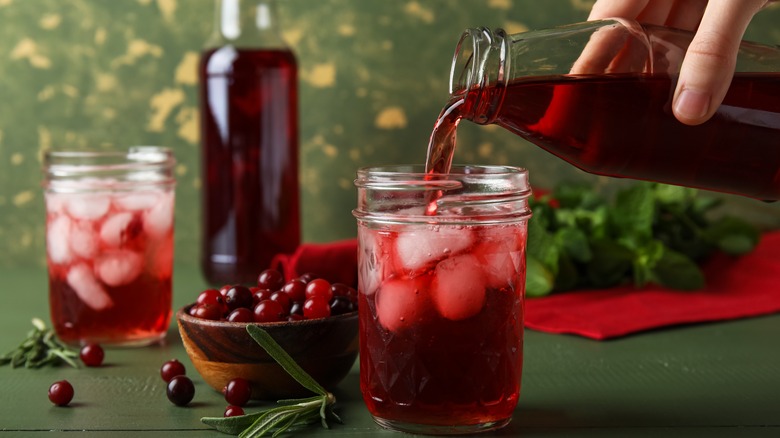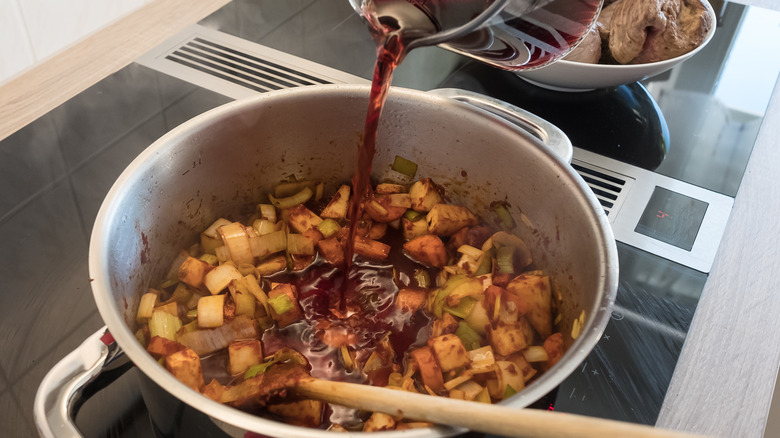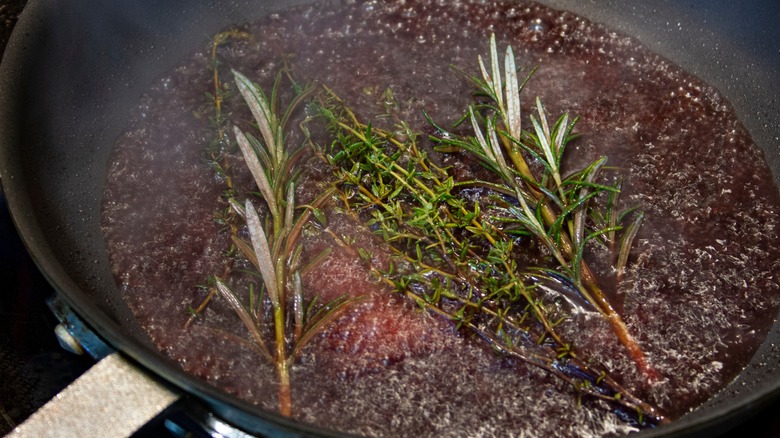Need A Quick Wine Substitute For Deglazing? Consider Cranberry Juice
As cozy and comforting as weekend wine nights can be, there are uses for vino beyond just drinking. Namely, cooking. Whether you're making a red wine-poached pear or using red wine in a tenderizing meat marinade, wine is particularly handy when you want to deglaze a pot or pan. When you cook proteins or vegetables in a pan, they often leave caramelized browned bits, called fond, stuck to the bottom and sides of the pan. "Deglazing" the pan with wine loosens this flavorful fond from the pan and returns its rich, charred flavors back to the dish while leaving behind delicate traces of the wine's flavor profile. But if you don't have red wine on hand, or just don't want to use alcohol, you can turn to cranberry juice.
The key to deglazing is using a liquid that's high in acidity, and cranberry juice boasts a pH balance of 2.5. In layman's terms, this means cranberry juice is acidic, making it a great deglazing substitute for red wine. Like red wine, cranberry juice brings a distinct tartness and fruity flavor to many dishes, which can enhance their overall taste profiles and provide an unexpected yet balancing twist to savory dishes.
Considering cranberry juice varieties
As with most fruit juices, cranberry juice is available in different forms, and the type you use to deglaze your pot can affect the overall tone of the dish. So, which is the best choice for deglazing — 100% cranberry juice, cranberry juice cocktail, or mixed-berry cranberry juice?
Pure, 100% cranberry juice is what it sounds like — a beverage made solely from the juice of cranberries. Like red wine, this unadulterated juice contains tannins, compounds that flaunt a complex flavor profile marked by shades of tartness, sweetness, and bitterness. The intricate flavor of 100% cranberry juice is your best bet for deglazing when you don't have red wine, as it closely mirrors the characteristics of red wine.
Unlike its 100% pure counterpart, cranberry juice cocktail has added sugar or high-fructose corn syrup to make the drink sweeter and more palatable to those who don't enjoy tart flavors. Not only will the added sugar overshadow the sophisticated flavors of pure cranberry juice, but if sugar gets too hot, it can burn and leave behind a scorched taste. If you can, avoid using cranberry juice cocktail to deglaze a pot and save it for sipping.
Another cranberry juice option is one that's been infused with other berries, such as blueberries, strawberries, and cherries to temper cranberries' subjectively brash flavor. A mixed-berry cran juice that's sugar-free and made from 100% fruit juice is an excellent deglazing option that brings additional shades of flavor into your dish.
Tips for deglazing with cranberry juice
Deglazing a pan might seem like an expert move, especially when you're using an unconventional liquid. But don't be intimated — here's everything you need to know to become a deglazing pro.
Before you add the deglazing liquid, in this case, cranberry juice, to your pot or pan, transfer the food to a separate dish to avoid overcooking it. Keep the pot or pan heating over medium to high heat before you pour in your cranberry juice; now is when to incorporate additional herbs, spices, and aromatics to give the sauce or gravy that you're making a flavor boost. Once the liquid begins simmering, use a rubber spatula to scrape the fond off of the sides and bottom of the cookware. Continue to simmer and stir until the cranberry juice is reduced by half.
If your sauce or gravy is too thin for your liking, the best tips for fixing thin sauces include introducing a thickening agent such as flour or a cornstarch slurry, or adding a dash of heavy cream or butter at the end of the deglazing process. Et voila — a cranberry juice-based sauce perfect for pouring atop charred meats for a flood of flavorful moisture. Next time you need to deglaze a pot but you've finished off your red wine, save yourself a trip to the wine shop and reach for your cranberry juice instead.


